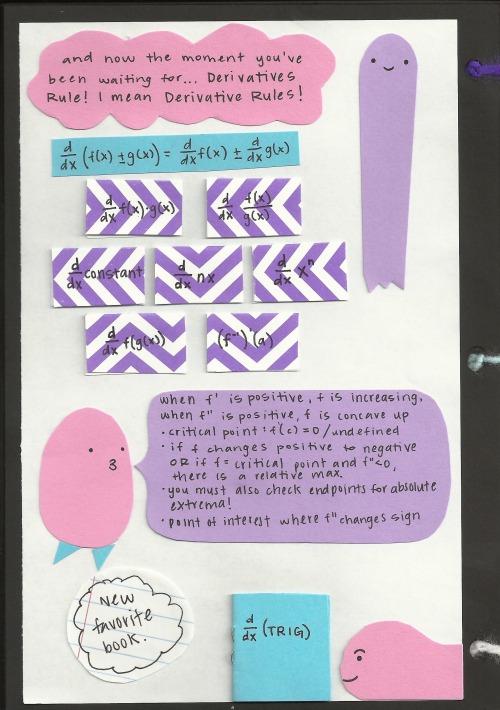Marathon-notasprint - To Help Me

More Posts from Marathon-notasprint and Others
Organising a Notebook:
I was looking at methods of keeping notebooks organised and I came across a really interesting blog post (source) that I want to share with you all. All of the pictures in this post come directly from the original blog post.
Make your entry into your notebook. In the example photographs, they have recorded a Chinese recipe.

Go to the back of the notebook and add a tag or title, e.g. “Chinese” on the left edge of the page.

Go back to the first page where the entry was, and on the same line number as you wrote “Chinese” make a black mark on the edge. You make this mark so that even when the notebook is closed, the mark is visible. After repeating this for various recipes, you now have various tags visible on the notebooks edge.

If you ever wanted to find a Chinese recipe, you simply look at the index, locate the label, and look along the visible edge which has been tagged as Chinese. Then just flick to each marked page.

You’re not limited to one tag per page. You could tag a page 2 or 3 times. So if you jot down a chicken stir fry you could tag it as “Chicken” and “Chinese”.
Note taking masterpost:
An anon requested this today. I though I had already made one, but apparently not.
General note taking and guides:
Combining lecture and reading notes
Resources about making chapter outlines
Recognising key points in a lecture / reading (for efficient note taking)
10 tips for good note taking in lectures
Guide to note taking (the major approaches and techniques)
What to do after you take your notes
Organising a notebook
Taking notes that work (By Dustin Wax)
Top note taking tips
An example of me using cornell notes
Visual / Pretty Notes:
Visual guide to illustrating notes
How to make your notes prettier!
Pros and cons of pretty notes
Guide to colour coding
Guide to my graphic notes
How to make notes cute and neat
Inspiration: 1 / 2 / 3 / 4 /
Electronic Note taking:
Guide to taking typed notes
Handwriting versus typing your notes
Organising your typed notes
Note taking apps
Medical Textbooks (PDF versions)
Hi Everyone!!
I was asked by @dankamphetamemes to share my holy grail textbooks and I did, but I thought I’d do you guys one better. I recommended that you should check them out in PDF versions before you buy them because honestly they’ll burn a hole through your pocket - so I gathered all the books I use and a couple of others for you to check out!!
Heres a list of books you’ll find in my google drive:
- Robbins and Cotran’s Pathological Basis of Disease
- BRS Pathology
- Lippincott’s Biochemistry
- Lippincott’s Pharmacology
- Physiology by Linda Costanzo
- BRS Physiology
- Moore’s Clinically Oriented Anatomy
- Gray’s Anatomy Flashcards
- Unfortunately I couldn’t find a PDF version of Medical Microbiology by David Greenwood - Ill keep looking and upload it when I find it
Extra books/flashcards:
- Guyton and Hall Textbook of Physiology
- Clinical Microbiology made ridiculously simple
- Netters Anatomy Flashcards
- Snells Clinical anatomy by regions
If you happen to face any trouble downloading them or accessing them shoot me a message and let me know
Here’s the link - enjoy!!
https://drive.google.com/folderview?id=0ByVv1ccrvWveUGVuZFRCQWp3MDQ&usp=sharing



{28/03/15} - It’s embarrassing how much making these excites me… trying to make a subject I find boring a little more amusing and I think it’s working?

bi·ol·o·gy \bī-ˈä-lə-jē\ noun - the branch of knowledge that deals with living organisms and vital processes
I’ve noticed that there are quite a few younger studyblrs and since biology is usually the first high school science students take, I thought I’d make a post on how to study for it as it is my favorite subject.
1. Use Diagrams
Biology textbooks are full of diagrams and they’re there for a reason. Always look over the diagrams and copy ones on important topics (e.g. photosynthesis, taxonomy) into your notes.
2. Memorizing & Understanding
I have heard many people say biology is just memorization, but it’s really not that simple. There is a lot of memorization involved for vocabulary and basic information, but biology is also full of processes (e.g. cellular respiration, evolution). You cannot just memorize the steps, you must fully understand what purpose each step serves. Many tests have short answer or essay portions and there’s no way you can answer them by just memorizing the steps of a process without understanding them. I recommend drawing out diagrams and mind maps for understanding processes and cycles as that really helped me. Once you can teach someone else how that process/cycle works, then you really know it.
3. Color code
Color coding is useful for many subjects including biology. Color code your diagrams (it always comes back to the diagrams) and graphs as it makes looking back over your notes much easier and it keeps things organized and easy to study which is important since there are many complicated processes and cycles (e.g. DNA replication, transcription, & translation) that can get confusing if drawn all in one color.
4. Pay attention to labs
You’ll probably do quite a few labs during your time taking biology. Labs serve to let you see concepts in action for yourself which can really aid understanding. Always record data down in your lab notebook and do the conclusion questions. The conclusion questions gauge how well you understand the labs. Most importantly never ever record results you didn’t get. A lot of times (especially in basic high school biology), you will go into a lab with a pretty good idea of what will happen, but if your results don’t match your hypothesis, it’s okay. I remember once I did a lab involving different sugars and enzymes and I was sure of my hypothesis, but my results didn’t match my prediction. After a class discussion, we found out that quite a few other people didn’t get their expected results either and it turns out the enzymes we were using were expired. So if you don’t get the expected results, maybe you did the lab wrong or maybe not, either way don’t fake data, talk to your teacher instead.
5. Learn your word roots
A lot of biology terms (particularly anatomy and biomed) are from Greek and Latin roots. Now you don’t need to go take a Latin class or anything, but look up etymologies and focus on recurring prefixes and suffixes (e.g. hemo-, hypo-, -cyte, -derm) and soon you’ll begin to be able to predict what a term means before looking it up.
6. Review
A lot of concepts in biology are interconnected and you need to know one topic to understand another. For this reason, always review anything you’re rusty on especially if you plan on taking other biology classes in the future.

This is how heart works <3 <3 <3

STUDY METHODS (part 1)
i’ll be posting soon part 2 (Study methods part 2 here)
*Please excuse my english if necessary*
Puedes encontrar esta misma imagen en español aquí
-
 acequeenjomarch reblogged this · 5 months ago
acequeenjomarch reblogged this · 5 months ago -
 keychainjar liked this · 5 months ago
keychainjar liked this · 5 months ago -
 brightkinds reblogged this · 5 months ago
brightkinds reblogged this · 5 months ago -
 falafela reblogged this · 1 year ago
falafela reblogged this · 1 year ago -
 saturniinne liked this · 1 year ago
saturniinne liked this · 1 year ago -
 cherrychapstickandfadedscars reblogged this · 1 year ago
cherrychapstickandfadedscars reblogged this · 1 year ago -
 weirdograph liked this · 1 year ago
weirdograph liked this · 1 year ago -
 alwaysforlove reblogged this · 2 years ago
alwaysforlove reblogged this · 2 years ago -
 missloro liked this · 2 years ago
missloro liked this · 2 years ago -
 peachybeat reblogged this · 2 years ago
peachybeat reblogged this · 2 years ago -
 toeswhitepusssytight reblogged this · 2 years ago
toeswhitepusssytight reblogged this · 2 years ago -
 arbusthesnek liked this · 2 years ago
arbusthesnek liked this · 2 years ago -
 purestpoison liked this · 3 years ago
purestpoison liked this · 3 years ago -
 darlsnangels liked this · 3 years ago
darlsnangels liked this · 3 years ago -
 laithnajah-iraq liked this · 3 years ago
laithnajah-iraq liked this · 3 years ago -
 serenityinpoetry-blog liked this · 3 years ago
serenityinpoetry-blog liked this · 3 years ago -
 acolossallove reblogged this · 3 years ago
acolossallove reblogged this · 3 years ago -
 acolossallove liked this · 3 years ago
acolossallove liked this · 3 years ago -
 tiger-feather liked this · 3 years ago
tiger-feather liked this · 3 years ago -
 flower-child-xoxo reblogged this · 3 years ago
flower-child-xoxo reblogged this · 3 years ago -
 deanne1111 reblogged this · 4 years ago
deanne1111 reblogged this · 4 years ago -
 ironstarlightgiver liked this · 4 years ago
ironstarlightgiver liked this · 4 years ago -
 fadwaalnahi liked this · 4 years ago
fadwaalnahi liked this · 4 years ago -
 flower-child-xoxo reblogged this · 4 years ago
flower-child-xoxo reblogged this · 4 years ago -
 acolossallove reblogged this · 4 years ago
acolossallove reblogged this · 4 years ago -
 theoryofchoas reblogged this · 4 years ago
theoryofchoas reblogged this · 4 years ago -
 lavandamar liked this · 4 years ago
lavandamar liked this · 4 years ago -
 patchwork-ghosts reblogged this · 4 years ago
patchwork-ghosts reblogged this · 4 years ago -
 anythingsworld liked this · 4 years ago
anythingsworld liked this · 4 years ago -
 flower-child-xoxo reblogged this · 4 years ago
flower-child-xoxo reblogged this · 4 years ago -
 loveelee liked this · 4 years ago
loveelee liked this · 4 years ago -
 sxmplicity reblogged this · 4 years ago
sxmplicity reblogged this · 4 years ago








